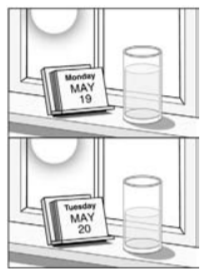What powers the water cycle?
What is the sun?
As latitude decreases, temperature
What is increases?
Fill in the blank,
Climate is the average of weather conditions in an area over a ________ period of time.
What is long?
As you go up a mountain the temperature goes...
What is down?
The sun changes the state of water from a liquid to a gas in what process?
What is evaporation?
The pattern of temperature and precipitation over several decades describes what?
What is an area's climate?
Rain, sleet, snow and hail are examples of what process?
What is precipitation?
True or False,
Global warming is the decrease in Earth’s average atmospheric temperature.
What is false?
Fill in the blank,
A ____ _____ is a matter that absorbs thermal energy but does not change state or significantly increase in temperature
What is a heat sink?
Water turning from vapor into rain droplets is an example of what process?
What is condensation?
A loose rock or soil formation that has been saturated with groundwater is a...
What is an aquifer?
Why does it rain more in the summer?
What is warmth?
Describe the difference between weather and climate.
What is weather is the state of Earth's atmosphere at a specific time and place, whereas climate is the weather in an area over a long period of time?
What processes put water vapor into the atmosphere?
What is evaporation, and transpiration?
How do clouds form?
What is as warm air rises, it expands and cools allowing the water vapor to condense?
What heats faster during the day, the land or sea?
What is the land heats must faster. It is a better conductor and water has a greater specific heat. This is why coastal areas have more consistent temperatures?
evaporation and precipitation are ______ in the atmosphere; if evaporation increases, precipitation _______.
What is balanced/similar, increases?
What is this process called in the water treatment?
(The water and floc enter a settling tank. The water flows slowly to allow the floc to settle to the bottom of the tank.)
What is sedimentation?
What are three factors that affect climate? (Useful hint: there is 3 of them)
What is latitude, nearness to a large body of water, and elevation?
Why are the polar zones so cold?
What is because of less direct sunlight?
The people of a city rely on runoff flowing into a lake to meet their water needs. They are concerned that there is less water in the lake this year than in the previous year. How can they collect data to test if their concern about the lakes level is valid?
A. compare this and last year's average water usage
B. compare the lake's current water level to its previous year level
C. measure the lake's water density
D. measure the air temperature to find out how fast the water is evaporating
What is B, compare the lake's current water level to its previous year level?
The figures below illustrate a glass of water left on a window sill.

Which statement describes what has happened?
A. Water has changed from a gas to a liquid.
B. Water has evaporated from the glass.
C. The liquid water has turned into a solid.
D. Condensation has caused the amount of water in the glass to increase.
What is B, Water has evaporated from the glass?
On a cold day in winter, Jasmine breathed on the cold car window. The window fogged up enough so that she could write her name on the glass with her finger. Why did the fog form on the window?
A. Her warm breath caused precipitation when it hit the cold air.
B. The moisture in her breath condensed when it hit the cold glass.
C. The warmth of her breath melted the clear layer of ice on the window.
D. Her breath contained moisture droplets that evaporated against the window.
What is B. The moisture in her breath condensed when it hit the cold glass?
/Some places have large changes in temperature during a year, and other places have small changes. Which of these places has the climate with the smallest annual temperature change?
A.
arctic plain
B.
temperate desert
C.
tropical rain forest
D.
temperate woodland
What is C, tropical rain forest?
Which pair of processes helps recharge aquifers?
A. rain falling on the oceans and on land
B. glaciers breaking off and melting
C. snow and rain falling on land
D. melting glaciers and sea level rise
What is C, snow and rain falling on land?